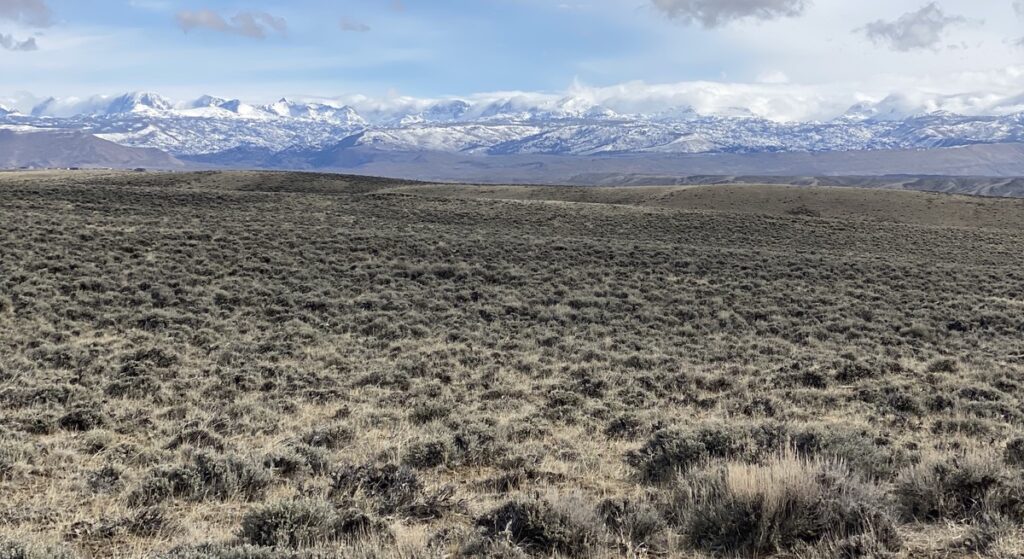During an especially hot and dry summer in Pinedale, Wyoming it’s hard not to reflect on the looming predictions of increasing temperatures and precipitation variability. The two combining to create high-temperature drought conditions, which are becoming more common across the planet. Growing up on the east coast in suburban Virginia, a drought did not mean much for me beyond a nice week at the local pool. Having spent the last three summers working in Wyoming during what has been a multi-year drought, my perspective has shifted, and I recognize how individual livelihoods are tightly coupled to weather conditions. A year with below average rain or snowfall means a year with minimal forage production for livestock. This can force ranchers into difficult positions when it comes to sustaining their operation.
In a livestock grazing system, profit is highly sensitive to forage production. While much of the west is broken into large tracts of native plant communities, these communities are still vulnerable to drought conditions that exceed historical averages. Often high temperature or multi-year drought conditions lead to a sharp decline in aboveground production for native perennial bunchgrasses. Native annual forbs, which offer a nutrient rich forage option, are also highly dependent on precipitation events, and in some cases high temperature droughts can trigger the loss of annual forbs for the season.
This is exactly what I am seeing in the Upper Green River Basin of Southwest Wyoming. Perennial bunchgrass production is lower than previous years, and when new growth is present it is being grazed intensely. Annual native forbs have been sparse throughout the basin, and where the cooler early summer months like May and June would see fields of colorful flowers it is instead replaced by the faded green shade of sagebrush and the brown tones of senesced bunchgrasses. The goal of my research this summer is to set up a multi-year experiment on the impacts of shifting precipitation patterns and grazing intensity. Lucky for me, my field technician is from a cattle ranching family in south central Wyoming. Viewing the landscape through his eyes has been so important in solidifying the importance of forage on these public land allotments. When we arrive at a site it has become a habit for me to ask him, “Would you let your cattle run here?” and at nearly every location the answer is a firm “No.”

What does this mean for ranching operations? Let’s look at the hypothetical example of a small ranching operation that owns a couple hundred acres along a river in southern Wyoming. Often these ranches have access to a few thousand acres of public grazing allotments that are used for spring and early summer grazing. For fall and winter forage the ranch may choose to graze some of their riparian meadows, reserving some for hay production which provides forage through winter months. Now consider a multi-year drought hits the region. Drought conditions result in the loss of public land forage production. This is particularly true of the sagebrush uplands (most public land allotments in Wyoming are upland sagebrush). With public grazing allotments suffering a lack of forage, ranchers are forced to make a decision to either sell-off part of their herd to deal with limited forage or purchase supplemental feed from another operation to maintain their herd size. Both decisions have negative consequences, climate change has made drought conditions harder to predict making it difficult to plan for a drought cycle by selling your herd other ranches come to the same conclusion. Sell-offs during drought can flood the beef market causing a decline in price. Buying hay to supplement forage comes with the risk of adding an additional cost with the hope that drought conditions lift and you can maintain your herd size. The emphasis here is on hope, a drought that lasts for multiple years may put a small operation too far in the red to recover financially.
Beyond impacts to the ranching community, drought conditions and the subsequent lack of production has direct implications for wildlife that depend on the sagebrush steppe. With the lack of annual forbs, mature sage-grouse have already switched to a diet of sagebrush, which is generally a winter forage. While adults are able to process the terpenes in sagebrush leaves, the chicks are not and depend on native annual forbs to supplement an insect heavy diet. Compared to previous summers, pronghorn seem to be less abundant in the sagebrush allotments I have been visiting, and there are clearly fewer fawns around. Their diet depends heavily on forbs and it is likely they’ve migrated higher in the mountains or further north where drought conditions are lessened.
All of this sounds pretty bleak, and I’m sure you may be wondering what can we do? The answer is complicated, most research on the impacts of climate changes for plant communities concludes that large-scale shifts in species abundance are imminent. In drylands, this shift is toward increasingly drought tolerant species and annual forbs that make use of sparse rain events. Drought tolerant species tend to produce less above ground forage and annuals are sporadic in nature. Neither is a replacement for perennial bunchgrass that act as the main forage component for livestock under current management practices. While this doesn’t answer the question, it does summarize the challenges facing livestock operations in the West.
Before I touch on solutions, I think it’s important to remember my background as a researcher who grew up on the east coast lacking monetary or familial connections in the West. Solutions will have less traction if they don’t come from the communities who face the brunt of the climate change burden. It is likely with shifting plant communities and an increase in precipitation variability that current management strategies that consist of minimal cattle movement and repeatedly grazing on allotments will be unsustainable. Returning to a more labor-intensive grazing rotation and herd system may be a more viable option for ranching operations in the West. In general, smaller, mobile herds are able to capitalize on short productivity bursts and cover larger distances in search of forage. I expect the immediate reaction to this suggestion is that moving cattle long distances costs more money and decreases daily weight gain. I fully recognize that there is no silver bullet to the concerns of ranchers. Coming up with a solution that works for all parties invested in the continuation of public land grazing and the accompanying land stewardship is dependent on a close partnership between research institutions and livestock operations.

Scott Carpenter, Western Resource Fellow| Scott is a doctoral student in the School of the Environment at Yale University where he researches the impact of changing precipitation patterns on plant communities in the Intermountain West. Following his undergraduate degree at Princeton University, Scott worked as a project manager for an NSF-funded ecological study at Ol Pejeta conservancy, Kenya’s second largest cattle operation and premier rhino tourism destination. While living in central Kenya Scott developed an interest in mixed-use rangelands, particularly how increasing climate variability influences plant communities and the subsequent consequences for wildlife and livestock. His research in Southwest Wyoming focuses on the impacts of shifting precipitation patterns and increased variability for big sagebrush plant communities through a mix of process-based modeling, field experimentation and survey methods. See what Scott has been up to. | Blog

